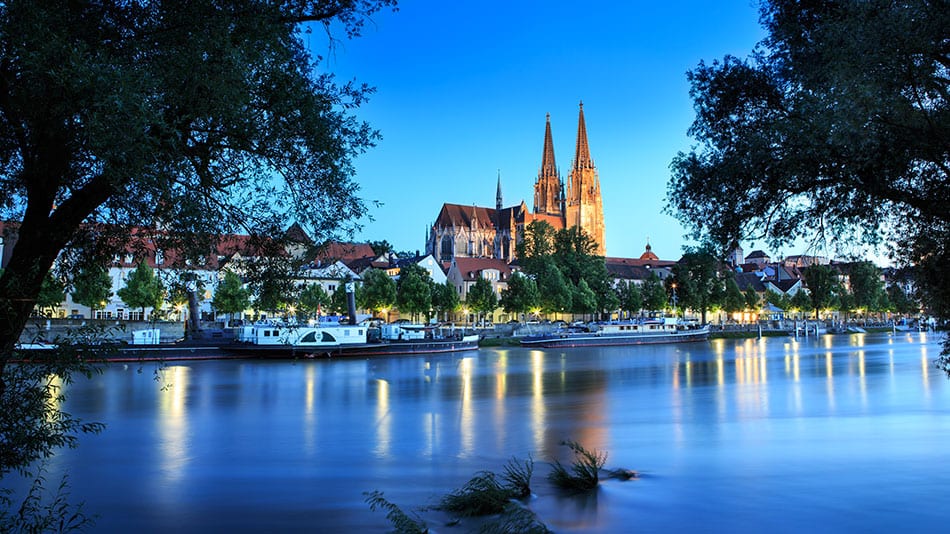THE RIVERS AND CANALS OF EUROPE ARE OPEN FOR TRAVEL
As many as 20,000 total miles of inland waterways let travelers absorb European culture at a relaxed, leisurely and up-close pace. The waterways of Austria, The Czech Republic, England, France, Germany, Hungary, Ireland, Italy, The Netherlands, Portugal, Russia and others now have many options to meet the growing demand for river cruising.
No longer an obscure way to see old Europe, travel by river is one of the best ways to venture out and take in the heart of the continent. This guide looks at the options available to travelers wishing to take a trip through Europe from a river”s perspective, easing through the countryside at a pace that permits all of the culture”s best possibilities to unfold. Travelers who return from river cruises carry memories of very intimate encounters with the countryside, local people, and fellow passengers. River cruise and barging travelers inevitably become true enthusiasts for the experience.


A traveler can journey Europe’s waterways in a variety of ways. River cruising most often refers to river going cruise ships typically carrying fewer than 250 passengers. As such, river cruising ships are much smaller than mass-market, ocean-going vessels, but as river boats go, are on the larger end of the scale. Western and Central Europe have many river routes to offer the larger cruise boats. Popular itineraries include the Danube visiting Hungary, Austria and Germany and the Elbe River through Germany and the Czech Republic. In France, the Rhone and the Soane meander through Provence and Burgundy, while the Seine takes passengers through Paris and Giverny. In Northern Italy, the Po offers exciting opportunities with a variety of river cruise companies. Finally, the Volga, connecting St. Petersburg and Moscow provides a decidedly different way to port between these two magnificent cities. River cruises tend to be affairs of luxury, with an emphasis on informal, but upscale travel. Relaxation and intensive sightseeing are the main activities, as organized entertainment is somewhat limited on most river cruises, except for the occasional lecture or sing-along. Mostly, the crew allows passengers to enjoy their time as they see fit.
Cabins on larger river vessels vary in size from 90 square feet on older ships to over 200 square feet on newer. Most rooms are outside cabins, meaning they have windows for optimal sightseeing. The least expensive cabins are lower in the boat, while passengers pay more for higher rooms with better views. Cabins come with basic amenities, such as hair dryers and televisions, and are often very nicely furnished. The larger river cruise vessels have telephones and even Internet service.
Many first time river cruisers are delighted to discover that, unlike ocean cruising, there is very little boat motion. The mandated slow speeds and flat waters of the rivers ensure a quiet, placid voyage. It is often difficult when not on deck to even know the vessel is underway!
On longer trips, 7 days or more, the typical river cruise passenger is a well-traveled individual often over the age of 60. Shorter cruises typically attract a younger crowd. River cruises on the larger vessels do not always allow children under 12 as passengers, so make sure to check on any restrictions for families. The passenger manifest will be a mix of European and North American travelers, but most crews speak at least some English, and many are fluent. Individuals who require physical assistance when traveling should check with their travel consultant to determine the accessibility of any particular vessel for disabled passengers.?

Meals have always been a special part of cruising, and river cruises have maintained that tradition. On river cruise vessels, food is a key part of the experience, prepared by a dedicated chef, the ship”s captain, or a restaurateur in a small village. Europeans take great pride in their culinary skills, and practically everyone who has ever cruised along the rivers and canals of Europe has at least one story about an unforgettable meal or food experience. Special dietary considerations can often be accommodated if requested early in the booking process.
The peak season for river cruising is much the same as European travel in general, late spring through mid-fall and early November. The shoulder season, a real value, ranges from early March through mid-May. The autumn months coincide with grape season, and several cruise lines are fully booked during this time by wine connoisseurs. Finally, April is tulip season and cruises in and around the Netherlands are particularly popular then. However, many travelers are particularly fond of the cruises during November and December highlighting the Christmas markets.
As always, pack as lightly as possible, as space on the smaller ships can be at a premium. Your cruise operator will no doubt provide you with a list of recommended items to bring, but the usual recommendations of hats, sunscreen and sunglasses are often overlooked but very important, because so much of your time will be spent outdoors.
Europe and its waterways await you!
So how to choose the right vacation for you?
Vacations are an investment! With literally thousands of options, choosing the right vacation and the best value is difficult to sort through. That’s where I bring my 12 years of travel experience and expertise to do this right, and get you the best value for your money. With the backing of the largest travel consortium behind me, we have options you can’t find online. Plus our work just gets started once we book your dream vacation. Chat with us to learn more.
The world awaits you and we look forward to assisting you in choosing the exact right adventure on the waters or land for you and your companions!








